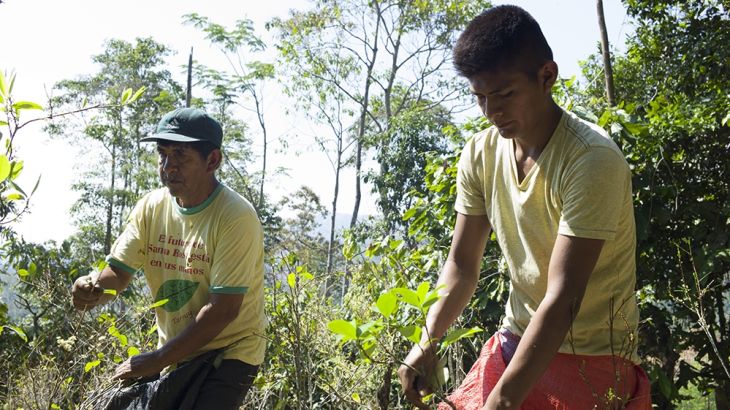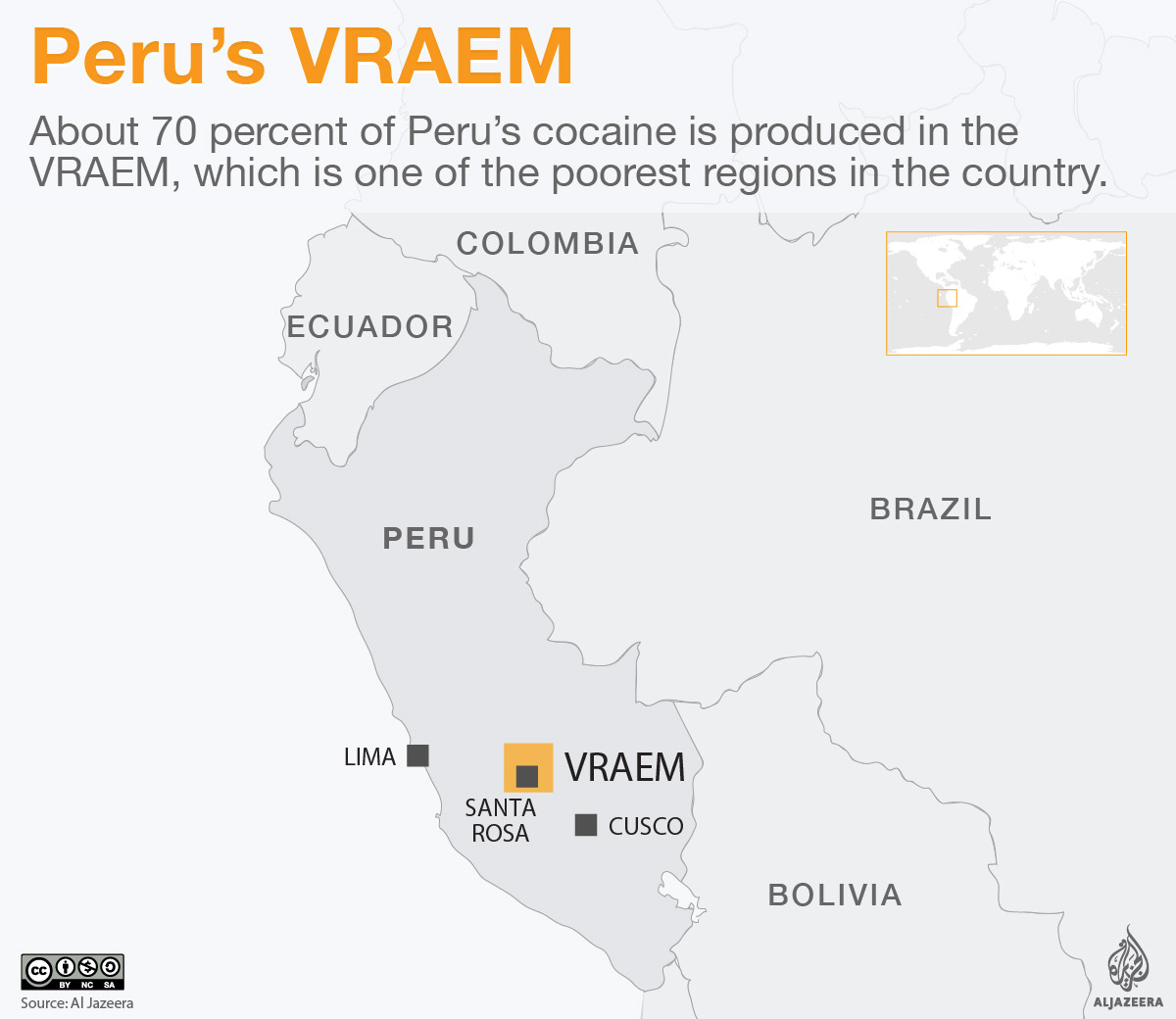Life in the VRAEM, Peru’s ‘cocaine valley’
A soldier, a local radio presenter and a coca leader give their view on life in Peru’s main cocaine-producing region.

The Peruvian region VRAEM, the valley of the three rivers Apurimac, Ene and Mantaro, has long been stigmatised by the outside world as a “lawless” region overrun by “narco-terrorists”. It’s a description that holds some truth: about 70 percent of Peru’s cocaine is produced in the region and it is home to the last remnants of the Shining Path, a Maoist armed group that fought a war against the state between 1980 and 2000. Today an estimated 300 fighters remain in the region.
But for the more than 400,000 people living in the VRAEM, their story is predominantly one of struggling for survival, with basic needs such as education, energy, asphalted roads and clean water often unfulfilled. Here, the economic potential of coca, the plant used to make cocaine, is unrivalled and can offer some respite in the face of poverty. A soldier who grew up in the region, a local radio presenter and a leader of the coca movement give us their take on living in the VRAEM.
Keep reading
list of 4 items‘Triple spending’: Zimbabweans bear cost of changing to new ZiG currency
‘We share with rats’: Neglect, empty promises for S African hostel-dwellers
Thirty years waiting for a house: South Africa’s ‘backyard’ dwellers
Omar Ore, 20, Soldier
![Omar Ore, 20, a soldier in the Peruvian army who grew up in the VRAEM [Shiori Ito/Al Jazeera]](/wp-content/uploads/2017/03/bc6eec587a2a4d4c8fa2d08972074bc2_18.jpeg)
“Ask any man my age in the VRAEM, they’ve all worked in the drug trade at some point. Everybody here is poor. Working in cocaine production offers a way out.
When I was 16, I used to ride my bike all the time and I started earning respect. This was when I started being offered work. At first I worked in a coca maceration pit, which is a clandestine cocaine lab in the jungle. I helped carry coca sacks and used chemicals to macerate the leaves and extract the coca alkaloids.
Later I began taking jobs as a mule, which is far more dangerous. We would go up the mountains and walk through no-man’s land until we would get to secret stash points, from where others would take care of deliver. Out there, there are few rules. People are killed for what they carry. You can’t trust anyone.
I quit because I sensed that I was getting in over my head. I started drinking and getting into fights outside of discotheques. Fights like those sometimes end up with someone getting shot. Some of my contemporaries ended up dead or with bullet wounds. Others ended up in prison or somewhere up the ladder of the drug trade risking everything. Very few left the drug trade behind altogether.
I chose to join the army when I was 18. I needed it to get a clear head so I could think about having a career and looking after my family. It hasn’t been easy. My ID gave away where I was from. At first the officers thought I was an infiltrator from the Shining Path, [a Maoist armed group which fought a vicious internal war against the state between 1980 and 2000. They still have a small presence in the VRAEM, with an estimated 300 fighters remaining]. The intelligence service was constantly questioning me. I have since proved myself as a soldier and hope to become an officer one day.
I always come back to the VRAEM on leave. My family won’t move from here. I sometimes speak to my father about whether things will ever change in the valley. Coca farmers are constantly in fear of having their fields eradicated. But from what I’m told coca production has only expanded this year.
I wish there was another way to make money in the region. Perhaps through industrialisation of coca for other uses, such as tea and flour. Now that I’m 20 years old, all I can see is that things are not the same as when I was growing up – they are intensifying. Life in the VRAEM used to be more rustic . Now many simple peasants have become master chemists.
A week ago I was working on our family coca field and I saw two plumes of smoke rise up not far from me. The police had discovered some cocaine labs and had blown them up. That’s an image most farmers are used to. It’s an almost daily occurrence. The police sometimes even bring reporters along to show off their work.
Three days later a clandestine pit like that will be operational again – and the cycle continues.”
Romulo Loayza, 40, Santa Rosa Radio Presenter
![Romulo Loayza, 40, is a local radio presenter in Santa Rosa, a small commercial town at the heart of the VRAEM [Shiori Ito/Al Jazeera]](/wp-content/uploads/2017/03/2900b9b2027c42f4a7fb226281e96a09_18.jpeg)
“I used to come to the VRAEM as a teenager on holidays to visit my father’s coca fields. Those were dangerous times during the internal war with the Shining Path. Years later after finishing my studies in agronomy I returned and settled here in Santa Rosa, [a small town at the heart of the VRAEM].
Ten years ago a friend of mine dared me to present on radio. Since then I haven’t stopped. Today I host a daily programme where I read the news and discuss issues that matter to local farmers. I’m known as “Radio Chaski”, which means “the messenger” in Quechua. I try to be as objective as possible, though I admit I also promote a line of fertilisers that I buy in Ayacucho.
I know what my fertilisers are used for coca production and, therefore, likely towards making cocaine. People here pretend otherwise, but that’s what sustains the local economy.
The new Peruvian president, Pedro Pablo Kuczynski, came to power on a ticket saying he would change things. That he would review ancient coca cultivation and finally bring coca eradication by creating a strong alternative market. But we’ve heard this kind of talk before.
The previous government headed by president Ollanta Humala invested millions of soles into the VRAEM in a crop reconversion programme, but barely half of it went to help out farmers. Most of the money went into the pockets of greedy intermediaries. They gave each coca farmer in the VRAEM cacao plants hoping that in three years’ time when the plants produced, the farmers would reap their rewards and there would be a miraculous shift in the region’s main crop.
But it will be difficult to displace coca. Cacao only harvests once a year while for coca it’s up to four times a year. And with coca the market comes to your door: the black market buyer will actually come to your farm. As it stands a coca farmer makes three times as much as any cacao farmer. It’s simple economics: the demand from outside dictates the production. The only thing that could ever change the coca market is if synthetic drugs would replace cocaine in the West.
The government can talk big but it’s too scared to effect real change. There’s too much at stake for them. Eradicating the country’s coca production would be bad for the Peruvian economy. It would also cause an uprising among farmers who are prepared to sacrifice their own lives.
Between 1990 and 2000, more than 5,000 rifles were given out by the Fujimori government to help self-defence militias in the VRAEM fight the Shining Path. These rifles were never returned and these units still exist. They provide security to the community as police are largely absent in the VRAEM.
And let’s not be naive. Last year army helicopters were caught transporting cocaine to the capital, Lima – even the military is involved in the drug trade.”
Paulina Pariona, 34, Women’s Coca Association Santa Rosa
![Paulina Pariona, 34, is a mother of four and a leader of the coca producers' movement in the VRAEM [Photo courtesy of Paulina Pariona]](/wp-content/uploads/2017/03/6979c55a62ae4803aa5f3f053bd5c49f_18.jpeg)
“My father was killed fighting alongside the self-defence militias against the Shining Path in 1986. Soon after, the Shining Path came to our house and killed my mother. I grew up with my brothers and sisters – we all endured great poverty and suffering. Those are times I prefer not to think about. But it’s what formed us. I never finished primary school.
Today I’m a mother of four and a leader of the cocalero [coca producers’] movement here in Santa Rosa. I will fight until my dying breath for the rights of coca farmers. Coca is what puts food on the table here in the VRAEM. It’s our only significant cash supply.
All our lives the government has vilified people from this region – they see us as drug traffickers. We are farmers. We would gladly convert to other crops like coffee and cacao but they sadly don’t bring financial results that can sustain us. Most of the earth in the VRAEM is too red with clay, barely suitable for anything else but coca.
What we want is for the government to review the system of legal membership of coca farmers, which was established in 1978. Today less than 20 percent of coca farmers in the VRAEM are registered under the scheme. What we want is something similar to what’s happening in Bolivia. We want each coca farmer to be registered and allowed the same sized coca patch. Anyone who grows more than allowed would have their accreditation taken away, and possibly have their patch eradicated. The coca would then be sold to ENACO, the national coca agency, making sure it would not fall into the hands of cocaine producers.
Coca has great potential for being industrialised for its many medicinal properties. But it’s the West that keeps failing to see its other potential uses for curing stomach cramps, hangovers and altitude sickness. We as farmers chew coca; it keeps us strong when we are working the fields. For us it is sacred.
The politicians are all dishonest; they only befriend us in times of elections and then vanish. They never fulfil their promises. When I was a town councillor, I tried my best to improve education and health, but the investments from the government were minimal. We are still much in need.
We don’t want to be demonised. We want to find a solution by legalising our coca fields, but the state has forgotten about us.”
